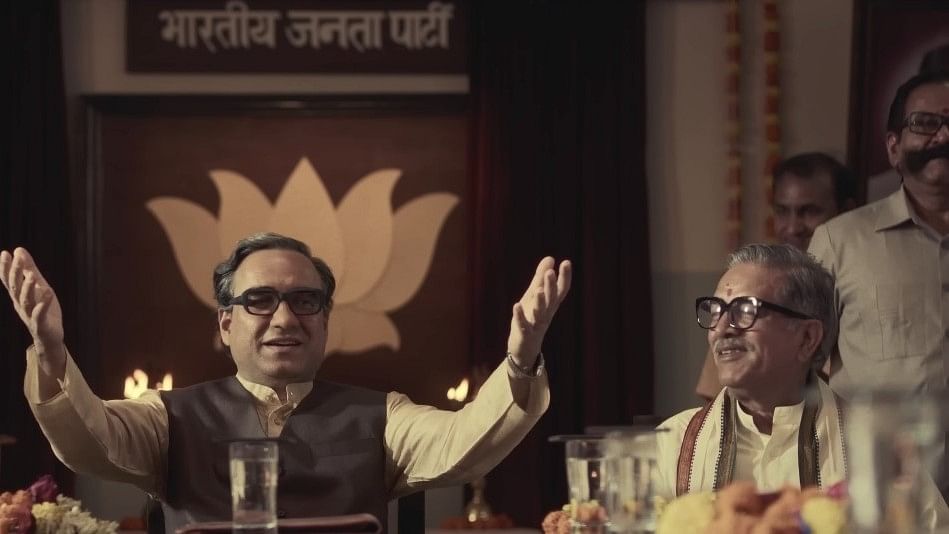
There has been an explosion of biopics of political leaders in the recent past and one of Atal Bihari Vajpayee (‘Main Atal Hoon’) is due to hit screens next week. The last biopic explosion was devoted to sports persons and Rakeysh Omprakash Mehra’s ‘Bhag Milkha Bhag’ (2013) was perhaps the last important film from that genre. Those films were straightforward in their patriotic thrust but patriotism has acquired a different significance now and biopics of political leaders have other discourses. Abhijit Panse’s ‘Thackeray’ (2019), Omung Kumar’s ‘PM Narendra Modi’ (2019) and Vijay Gutte’s ‘The Accidental Prime Minster’ (2019) are some films from the crop. It seems like they appear just when elections are around the corner and this was hardly the case with more noteworthy biopics like Richard Attenborough’s ‘Gandhi’ (1982) or Ketan Mehta’s ‘Sardar’ (1993), which also deserved to be taken more seriously.
However, even the more serious biopics do not make room for analysis as that would imply criticism. If we take the representation of Gandhi, for instance, the public view is an uncritical one unless it becomes vituperative as by Arundhati Roy or some extreme members of the Hindu right-wing. Anthropologist Louis Dumont noted that for the traditional Hindu mind nothing changes as far as values are concerned and Indian civilization is marked by a search for fundamental constants. Gandhian values are the ‘constants’ associated with the independent nation since they were enunciated by the Father of the Nation. The fact that Gandhi and Ambedkar are both ‘constants’ perplexes political writers, who nonetheless try to reconcile the two — when they stand for contrary things.
When we come to political leaders who are alive or whose followers still wield power the filmmaker is confronted by the need to identify the set of ‘constants’ by which the subject can be associated. Only enemies merit criticism (as condemnation) while other leaders must be represented as they represent themselves. But since most political leaders — even if they are dead — have followings, only someone not associated with India (like Jinnah) might be criticised in an Indian biopic. Biopics about regional politicians whose influence rests on animosities — like Bal Thackeray — cannot also be shown outside their own spheres; Thackeray’s discourse will be distasteful to those outside.
This leaves us with another key feature of the biopics which is the presence of a celebrated actor as the protagonist in each biopic, considering that Ben Kingsley was virtually unknown when he played Gandhi in Attenborough’s film. My own sense is that this is not simply because of commercial demands. Here are some roles: Sardar Vallabhai Patel (Paresh Rawal), B R Ambedkar (Mammooty), Bal Thackeray (Nawazuddin Siddiqui), Manmohan Singh (Anupam Kher), Narendra Modi (Vivek Oberoi), Jayalalithaa (Kangana Ranaut). Many of these performances have been highly praised but while some (Paresh Rawal) are more convincing than others (Vivek Oberoi), what then is the actual attraction in a star from cinema appearing as a leader? Attenborough’s film constructed a credible Gandhi virtually from ‘nothing’ since the lead actor was unknown.
A conjecture that might explain the attraction in casting a familiar face from cinema as well-known face from politics is that the charisma exuded by a film star is not unlike the ‘magnetism’ expected from an Indian political leader. Film stars have also done well as political leaders when their group affiliations support it. The star must already belong to a powerful local caste group (as with NT Rama Rao, who was a Kamma) or have a political legacy (Jayalalithaa who took over MGR’s mantle) but being a star has helped. But it is also significant that Jayalalithaa who had been paired off with MGR on the screen took over from him rather than his actual wife; they were perhaps even seen together as deity and consort. The film star and the leader are both elevated and are larger than life — as evidenced by their mammoth-sized cutouts.
The notion of the ‘darsanic gaze’ has been brought to bear by theorists on the Indian film hero. The object of the darsanic gaze is a superior, divine figure or a king who presents himself as a spectacle of dazzling splendour to his subjects. Unlike the hero of the democratic narrative, who is, by common understanding, ‘any individual subject’ with whom one might identify (as in the Hollywood film), Indian film heroes/heroines have sometimes had temples dedicated to them. This could naturally reflect upon how Indian actors will play political leaders, who have also been worshipped. If Attenborough’s Gandhi tried to acquaint us with the protagonist’s feelings as that of a leader as an ordinary person, not so the other Indian biopics that place the protagonist at a higher level, to be looked up to by ‘bhakts’ as political leaders often are. The appearance and the mannerisms of the subject are imitated faithfully but never is there an attempt to understand him or her as a person. Films like ‘Thackeray’ or ‘PM Narendra Modi’ even suggest that the leader is indistinguishable from his own professed ideals.
There are hence two aspects to the political biopic in India that are related in some way. Firstly, the leader is perceived as a ‘constant’ identifiable with his or her professed values and the struggle is simply the values being actualised. Secondly, the leader is represented by an actor and the earnestness of the actor is identified with the leader’s true values. It is comparable to how film fans see no difference between the star and his roles, which are perhaps merely avatars of the star. Except that in the biopic the star does not actually overshadow the role but merely points to it as a token of his/her reverence.
(The author is a well-known film critic)